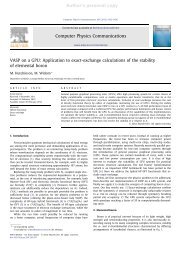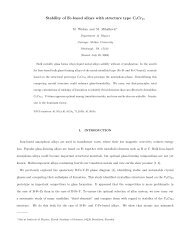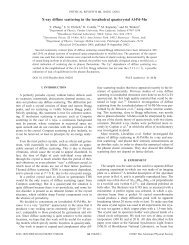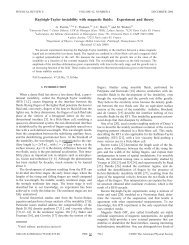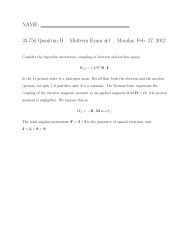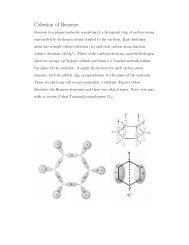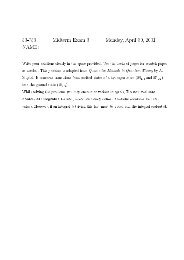A Free Energy Model of Boron Carbide W. P. Huhn & M ... - It works!
A Free Energy Model of Boron Carbide W. P. Huhn & M ... - It works!
A Free Energy Model of Boron Carbide W. P. Huhn & M ... - It works!
Create successful ePaper yourself
Turn your PDF publications into a flip-book with our unique Google optimized e-Paper software.
Author's personal copy440 W.P. <strong>Huhn</strong>, M. WidomFig. 3 Predicted phase boundaries for our model using calculated parameters as listed in Table 1 and aselection <strong>of</strong> values <strong>of</strong> β. Line compounds are β-boron at x = 0, graphite (not shown) at x = 1 and monoclinicboron carbide at x = 3/15. Carbon-rich phase boundaries <strong>of</strong> rhombohedral boron carbide are shown as solidlines, while boron-rich phase boundaries are shown as dashed linesResults for a selection <strong>of</strong> values <strong>of</strong> β are shown in Fig. 3. As expected, the monoclinicphase is destabilized above a temperature T 0 ≈ 600 K, at which it decomposes into a coexistence<strong>of</strong> carbon-rich rhombohedral phase together with graphite. This value <strong>of</strong> T 0 issurprisingly consistent with the location <strong>of</strong> the heat capacity peak previously reported thatwas obtained from a completely different method [10]. The maximum carbon content <strong>of</strong> therhombohedral phase is bounded below 20 %, owing to the logarithmic singularity in s(y) aty c = 1 creating an infinite slope in g(x,T ) (too weak to be visible in Fig. 2). Note that theGibbs phase rule [4] implies that rhombohedral and monoclinic boron carbide must havediffering compositions while in coexistence with graphite, hence xC ′ = 0.2000 is forbiddenin principle.At temperature 2400 K (around the melting point) the maximum carbon content dependson the value <strong>of</strong> β, and ranges from 19.9 % down to 19.7 % in our model for the given range<strong>of</strong> β considered, whereas the experimentally assessed limit is 19.2 %. The phase boundaryin coexistence with boron depends strongly on the value <strong>of</strong> β, as can be seen in Fig. 3. Theexperimentally assessed limit is 9 % carbon, but over the range <strong>of</strong> β values studied here,the limit ranges from 10–16 % carbon, strictly above the assessed value. This is a furtherindication <strong>of</strong> inadequacy <strong>of</strong> our model in the boron-rich limit.4 ConclusionIn this paper we propose a simple free energy model for boron carbide. We predict theexistence <strong>of</strong> two low temperature compounds, resolving the mystery <strong>of</strong> the assessed lowtemperature composition range. One phase, whose ideal composition is B 13 C 2 , has rhombohedralsymmetry throughout its wide high temperature composition range, consistent withexperimental observations. The other phase is a line compound <strong>of</strong> exact stoichiometry B 4 C



